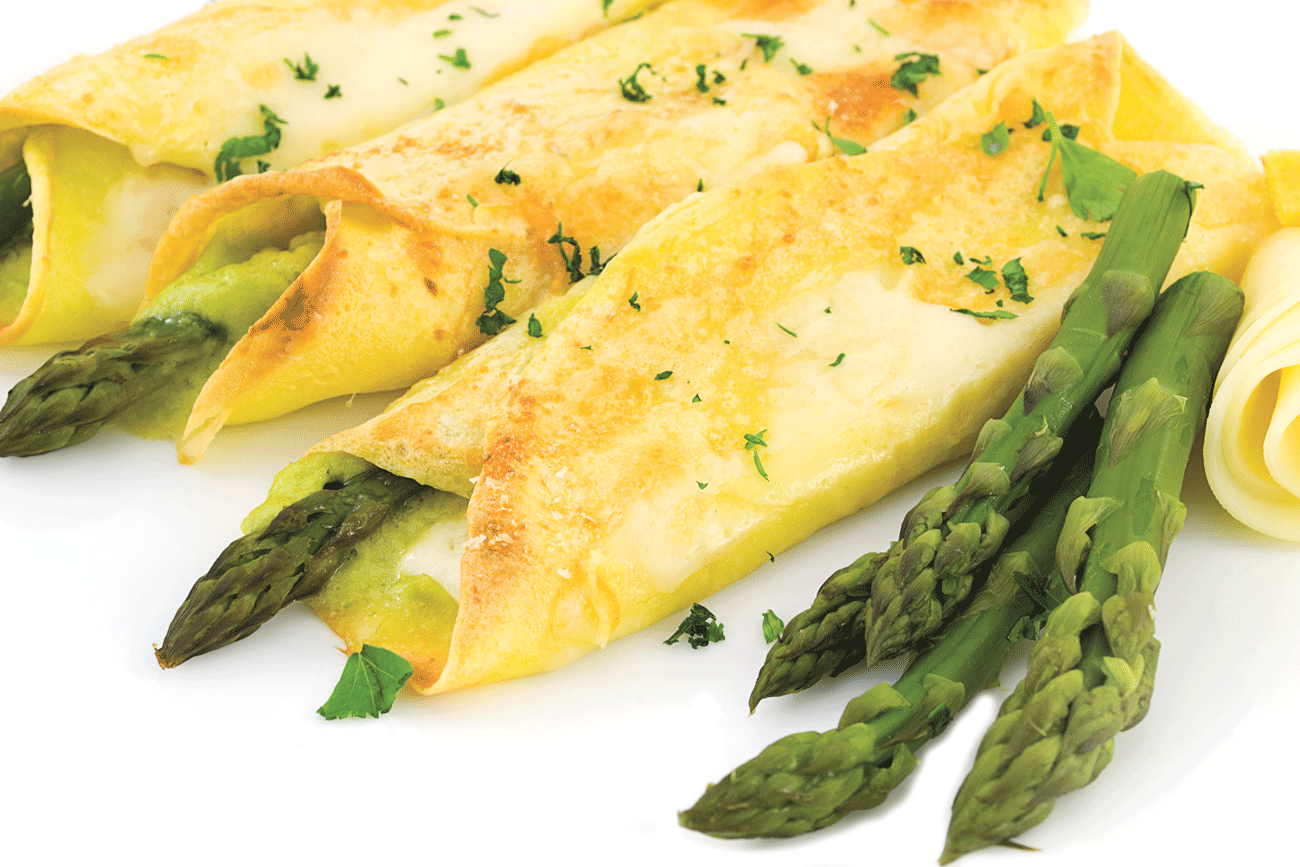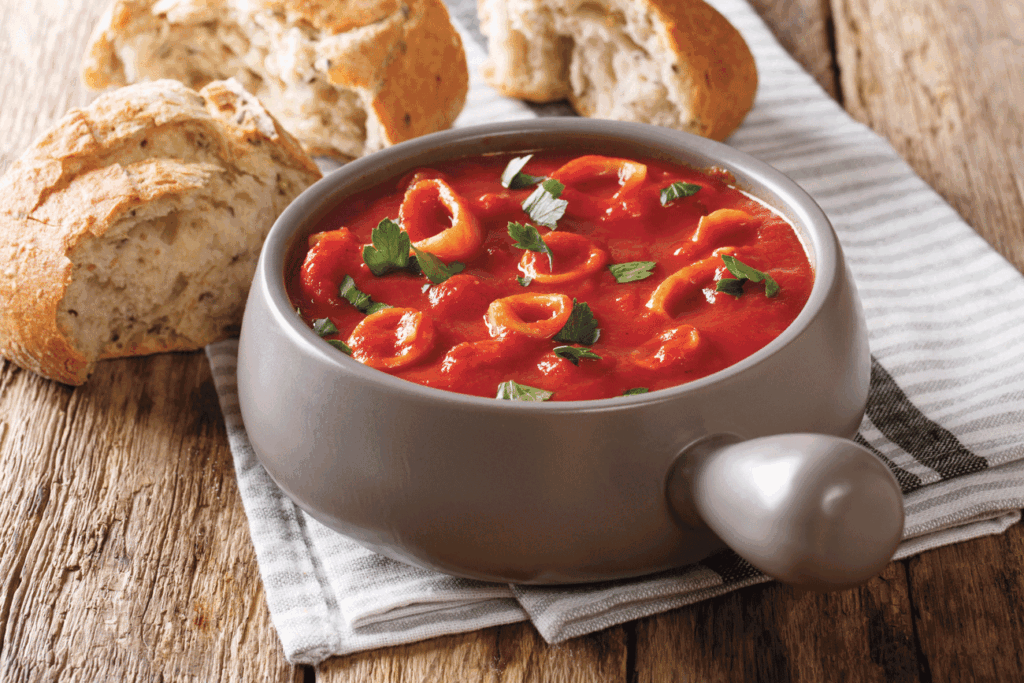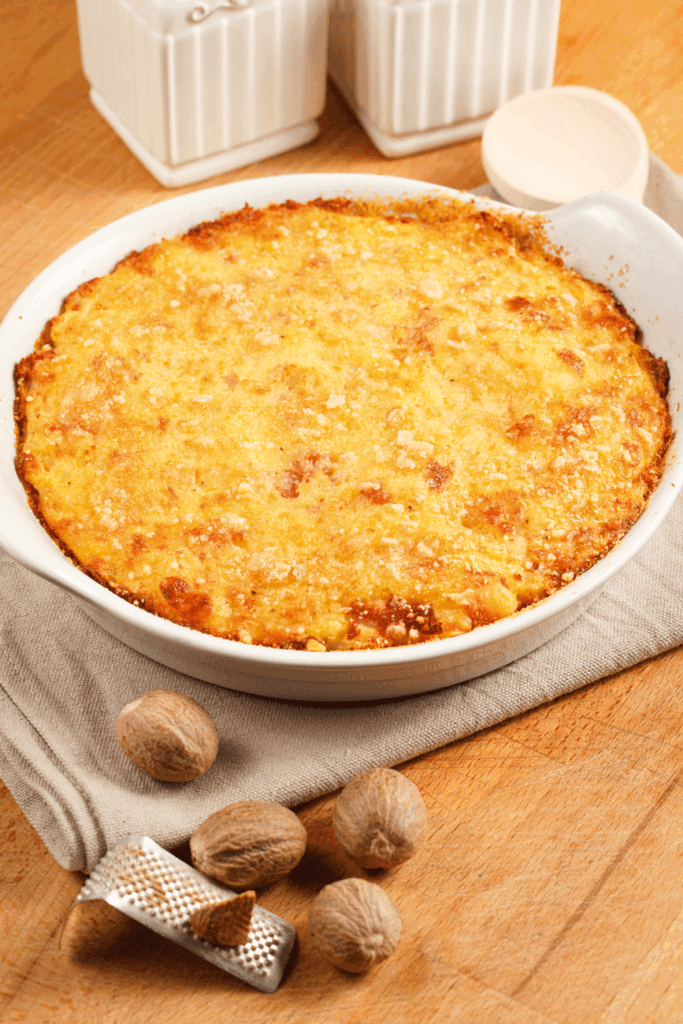
by Simone Conti
Asparagus Crepes – Serves 4
I hope you had a lovely May despite the lack of sunshine. We had occasional amazing days and the northern lights were really an unexpected gift. Summer is fast approaching and we start to see some lovely seasonal vegetables on the supermarket shelves. I’m keeping this month’s recipes very seasonal. I hope you enjoy them.
This is a very easy recipe. It’s asparagus season so it will be packed full of flavour and not too expensive.
Ingredients:
max 12 x 8” (20cm) crepes
500ml whole milk
250g plain flour
3 eggs
1 pinch of fine salt
Butter to taste
For the Béchamel
500ml whole milk
50g plain flour
1 pinch of nutmeg
1 pinch of fine salt
For the asparagus filling
600g asparagus
200g Gruyere cheese
30g butter
Fine salt to taste
Black pepper to taste
For the pan
2 tbsps grated Parmigiano Reggiano PDO cheese
Instructions:
1. To make the crepe dough – break the eggs into a bowl and beat with a fork. Then pour in the milk and mix well.
2. Sift the flour into bowl and mix vigorously with a whisk to incorporate into the mixture and avoid forming any lumps. When you have a smooth and homogenous mixture, cover the bowl with cling film and place in the fridge for at least 30mins.
3. To make the béchamel: pour the milk into a saucepan and heat, while melting the butter in a separate saucepan. When the butter has melted, add the flour in one go and mix well to avoid forming any lumps.
4. When a golden roux is obtained, add a pinch of salt and grated nutmeg. Pour in the hot milk slowly, while mixing, until the béchamel has thickened. Turn off the heat and set aside.
5. Take the crepe batter from the fridge and give it a stir. Grease a non-stick pan with a little butter and heat well over medium-low heat, then pour a ladle of the mixture into the centre of the pan. Spread it evenly over the entire surface with a special wooden tool or by rotating the pan. After about 1 min the batter will begin to thicken and detach from the pan. Then gently turn the crepe with a spatula and cook for 1 min on the other side. As crepes are ready, stack them on a plate and set aside.
6. To prepare the asparagus: remove the white part of the stem and boil for about 10-15mins in saucepan of water (cooking time can vary depending on size of asparagus stems). Take care to leave the tips out of the water so they steam cook. Once cooked, cut the asparagus stems into rings and keep the tips whole. Melt the butter in a pan, add the asparagus stalks and cook over high heat for about 5 mins. Then add salt and pepper.
7. Transfer the cooked stems into a mixer with steel blades and blend to reduce to a purée, then add ¾ of béchamel and blend again to obtain a smooth and homogenous cream. Stuff and assemble the crepe by spreading a spoonful of asparagus cream onto the surface of each crepe. Sprinkle grated Gruyere cheese and close the crepe by rolling it up on itself.
8. Take a large baking dish, grease with butter and place the stuffed, rolled crepes onto it. After arranging the crepes, sprinkle with leftover béchamel and decorate with asparagus tips, kept aside. Finally, add grated Parmesan cheese and black pepper. Turn on grill mode and bake everything for 5-10mins, until the béchamel begins to brown. Take asparagus crepes out of the oven and serve piping hot. Enjoy!
Suggested Wine – Viognier (France)

Braised Squid in tomato sauce – Serves 4
I love calamari and as I’ve mentioned many times, we’re blessed with top-notch fishmongers. I’ve included instructions on how to clean the calamari, but if you ask the fishmongers, they’ll clean it for you. I’ve moved away from fried calamari. I know it’s delicious but believe me, you’ll enjoy this recipe far more – it’s a much healthier option.class.
Ingredients:
1kg calamari (squid)
1 clove garlic
70g white wine
30g extra virgin olive oil
For the sauce
800g peeled tomatoes
20g extra virgin olive oil
1 clove garlic
Fine salt to taste
Black pepper to taste
Parsley to taste
Instructions:
1. For the sauce – pour the oil and garlic into a large saucepan. Let the oil flavour for a couple of mins over a low heat. Pour the peeled tomatoes into a bowl and lightly crush with a fork. When the oil is hot, pour in the peeled tomatoes. Allow it to cook on low heat for at least 30mins, stirring occasionally. If it dries out too much while cooking, dilute it with a little water. Once cooking is complete, the sauce will have thickened. Remove the garlic clove with kitchen tongs and set aside.
2. To clean the squid – rinse under running water. Then with your hands pull the head from the mantle. Continue to remove the transparent cartilage pen found in the mantle. Wash it thoroughly again and use your hands to remove the innards. Now to remove the outer skin make an incision with a knife on the end part of the mantle, just enough to grab a flap of skin and completely pull it off. Finally remove the fins.
3. Separate the head from the tentacles by cutting with a knife just below the eyes. Take the tentacles and remove the central beak. Now open the mantle like a book with the knife. Make an incision on the end part and cut the mangle and fins into strips about half inch wide. Leave the tentacles whole. Drain the squid in a colander. In the meantime, heat the olive oil in a skillet with the whole peeled garlic clove. Then pour in the cleaned, drained squid and sauté over high heat for 2-3mins. They will curl up. Deglaze with white wine and allow it to evaporate.
4. Remove the garlic with kitchen tongs and pour the squid with all the seasoning, into the tomato sauce. Add salt and pepper to taste and allow to cook covered with a lid, on a low heat for about 10mins. Once cooking is complete, turn off the heat. Finely chop the fresh parsley and add to the squid. Your braised squid is ready to be served hot.
Suggested Wine – Pinot Grigio (Italy)

Gluten-free Potato Cake – Serves 4
This is a very easy recipe and great for people who are coeliac or gluten intolerant.
Ingredients:
700g potatoes
150g sugar
70g of any gluten-free flour (ideally Almond flour is great)
5 eggs
30g butter
Zest 1 lemon
Pinch of salt
Pinch of gluten-free breadcrumbs
Icing sugar
Preparation
1. Start by washing the potatoes, place in a large boiling pan on a medium heat and boil for 30 minutes until well cooked. Use a fork to check they are cooked. Once potatoes are ready, drain and remove the skin, then allow to cool down for 10 minutes.
2. Once they are cool, mash in a large mixing bowl, make sure there are no chunks left. Start by adding flour and lemon zest, mixing with a wooden spoon, add the butter, sugar and pinch of salt and keep mixing with a wooden spoon. Now this is a very important part, start to add eggs but only one at the time! Make sure before you add each egg, that the dough has incorporated the previous egg. If you have an electric hand mixer, it will make the whole process easier!
3. Get an 8” or 10” baking tray, grease the base and sides with butter and sprinkle gluten-free breadcrumbs around the base and side. Now pour the mixture inside and make sure the top is nice and even. Place in pre-heated oven for 1 hour at 180c or mark 5-6.
4. Make sure the cake is well cooked by using a toothpick to pinch in the middle. If it comes out dry, the cake is ready! Allow to cool off for 20 minutes and then dust with icing sugar. The potato cake is now ready to serve. I will leave the decoration to your personal taste. I usually add fresh strawberries because my children love them!
Suggested Wine – Mateus Rose (Portugal)











